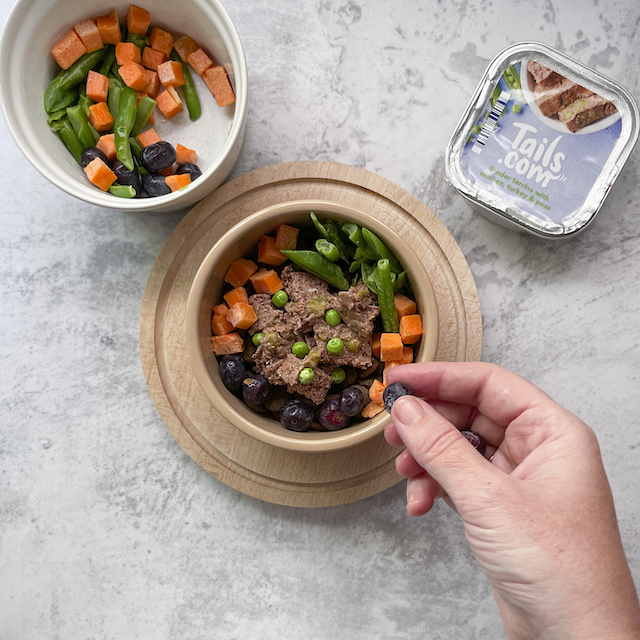Your adorable bundle of fur may be small now, but they grow up fast. To support their growth, puppies need special puppy food, packed with the right nutrition for healthy bones, teeth and muscle. A good diet should give your puppy all the energy they need for exploring and playtime. Because let’s face it, that’s what being a puppy is all about!
There’s a variety of puppy food available to buy, ranging from wet puppy food to dry puppy food. But with so much choice, it can be confusing for first time puppy owners. That’s why we’ve created this guide so you can be sure your pup grows into a happy and healthy adult dog.
What you should know when buying puppy food
A high-quality puppy food is the first step in giving your pup the best start in life. Your puppy’s body is changing and developing rapidly, which means they need more nutrients than an adult dog. Bouncy pups can also burn up to twice as many calories as adults, which is why most puppy foods have higher protein and calorie levels than adult dog food.
Since your puppy’s digestive and immune systems are still developing, tummy problems like vomiting and runny poos are common. As long as it’s not persistent, there’s usually nothing to worry about. However, it’s important to note that puppies are prone to intestinal parasites, so if tummy problems persist, it’s always best to seek advice from a vet.
To help support a healthy digestive system, many puppy foods include beneficial ingredients like prebiotics and added fibre. Here at Tails.com we include Beta-glucans and nucleotides in some of our puppy recipes as they’ve been proven to boost immune development in young animals. They can also help with enhancing antibody production after puppies receive their vaccinations. These added nutrients enhance your pup’s immune system while giving protection from bacteria and other germs.
Appropriate levels of other nutrients like calcium, magnesium, iron, zinc and vitamin D for your pup’s age are all essential to support strong bones and teeth. While higher levels of essential fatty acids are needed to support brain and vision development. At tails.com we can include salmon oil in our puppy recipes to boost levels of the fatty acid DHA (Docosahexaenoic Acid). Puppies get this nutrient from their mum’s milk, but studies have shown that supplementing DHA after weaning improves their learning ability, socialisation, memory function and vision development.
Wet puppy food or dry puppy food
There’s a long-standing debate around which type of food is right for puppies and adult dogs. But in truth, there is no right or wrong answer. You do what you feel is best for your pup. Both wet puppy food and dry puppy food come with their advantages. You just need to ensure you choose a high-quality food that has all the nutrients they need to support their growth. With this in mind, here are some of the main benefits of each:
Dry puppy food – As a natural abrasive, dry puppy food can help reduce tartar build up on your puppy’s teeth. This can go some way towards keeping their teeth clean as they grow older. But getting into a regular habit of brushing their teeth is the only way to prevent plaque and tartar. Dry puppy food is also one of the most convenient ways to feed your puppy. Simply pop it in a bowl and serve.
Dry food doesn’t spoil as quickly as wet food. You could technically leave the bowl down all day if you need to. It’s also easier to use as rewards while training, as well as in puzzle feeders and toys to bring mental stimulation and enrichment into your puppy’s life. And lastly, dry puppy food can be cheaper than wet food, so it’s a good option if you’re on a budget.

Wet puppy food – Since wet puppy food has a higher moisture content, it’s great for keeping your pooch hydrated. This can be useful if your pup doesn’t tend to drink a lot of water. Due to the high moisture content, it can also help your puppy feel fuller. This can be a good option if your puppy finishes their food and still seems hungry afterwards.
Wet puppy food is also great for teething puppies. Puppies lose their teeth between 14 and 30 weeks of age, and the pain can put them off their food for a while. But wet food will make mealtimes easier to manage. Many owners often find wet puppy food is more appetising for dogs, especially for fussy eaters that often need encouragement. Feeding time is convenient for pooch parents too. You just need to make sure you refrigerate the can after opening and dispose of any uneaten food after an hour or so, as bacteria will grow and contaminate the food.
How much should I feed my puppy?
Your puppy’s age, size, breed and activity level all affect how much you should feed your puppy. Unfortunately, there’s no single answer. And as your puppy’s digestive system isn’t fully developed, they won’t absorb nutrients as efficiently as an adult dog. This means they need to eat more to ensure they get all the goodness they need into their bodies.
Most puppy foods offer serving recommendations on the back of the packet. While this is a great starting point, it’s not exact. You’ll need to consider your pup’s exercise levels and metabolism and adjust your portions to the correct amount. That’s why as your puppy grows, it’s a good idea to monitor their weight and body condition monthly so you know if you’re on the right track. Most vets will let you pop into the practice and use the scales whenever you like. Many vets also offer yearly health plans where you can get ‘free’ weight checks with the vet nurse.
Luckily, we’ve taken some of the guesswork out of feeding your puppy with our Portion Scoop. You’ll get a handy little scoop with your food, along with a menu card to let you know how much to feed. It’s as easy as that!

Feeding your puppy
When feeding your puppy, it’s a good idea to offer the same food as the breeder initially. This will help your puppy adjust to the new environment and make it easier on their developing digestive system. If you want to change food in the long run, you can make the switch gradually once they’re settled into your home.
Puppies can easily become distracted or startled by the goings on of family life. We want your puppy to eat their food without interruption, so always ensure they have a nice quiet place to eat away from disturbances, like other dogs or children.
Puppies need to eat more frequently than adult dogs. Up to four months of age you should feed your puppy four meals a day. Consider how much food they need in a day and split this up into four servings. You can then bring this down to three meals a day up to six months of age, then two meals a day going forwards.
Your puppy is unlikely to finish their entire meal in one go. If that’s the case, simply take the bowl away and replenish for next meal time. If your puppy refuses to eat at all, take the food away and try again in an hour or so.
Be sure to take your puppy outside for a toilet break after each mealtime. All that food can put pressure on their tiny bladder and you’ll want to avoid any unnecessary accidents. Pop your puppy outside in the garden so they can do their business, then let them settle down for a nap. Puppies are naturally sleepy after a big meal and this will help them digest their food properly.
Best practices for feeding puppy treats
All puppies need to learn the ropes around the house, and that means you need to make time for training. But with good training practices comes lots of puppy treats! So if you’re using treats to train your puppy, make sure you factor this into their daily food so they don’t gain weight. Either reduce the amount you feed each meal time, or you can use their normal kibble as the reward.
When buying treats, always ensure you’re feeding treats that are suitable for puppies. Puppy treats will have ingredients that are sensitive to young tums, they’ll be smaller in size, and soft on developing teeth.
How tailored dog food can help your puppy every step of the way
Because puppies need a special diet with nutrients to support growing bones, muscles and cognitive function, tailored puppy food is the perfect choice. Here at tails.com we’ll create your puppy’s tailored recipe, just for them. Simply create your puppy’s profile in a few clicks and we’ll create a feeding plan that evolves with your dog from day one. There’ll be no figuring out how to adjust your dog’s diet for adulthood, we work out the changes needed for your pup’s nutritional needs, and your feeding plan will be altered automatically. And with our clever adjustable scoop, you can wave goodbye to complicated measuring and weighing. You’ll know you’re feeding your pup the right balance of nutrients and the right amount, every time.

You’ll get your pup’s tailored recipe delivered to your door every two weeks so they’re getting the nutrition they need for each tiny step. From 14 weeks old you’ll get a monthly delivery, introducing other kibble types and ingredients based on their size, activity level, breed and more. Into adulthood, we’ll keep adjusting your dog’s recipe so they continue getting the support and nutrients they need as they age.


My dog has recently turned 1, and has always loved Tails but has turned his noise up at his most recent bag.
Do you amend the blend at 1year and if so could this be the reason why?
Hi Michaela,
I’m not aware of blend changes. The best you can do is send an email to our customer service team and they can help you out! (hello@tails.com)
Kind regards,
Sophie
Hello sorry to jump on this don’t know how else to contact tails I’ve just received my box. Do I mix the dry food with the wet food.
Hi Crystal, how exciting that you’ve just received your first delivery! This is completely up to you and whatever your pup prefers. You can serve their daily portions separate or mixed together – or change this from day to day to offer them a bit of variety. For help with transitioning your dog over to their new food, you can watch our Nutrition Teams’ top tips here: https://www.youtube.com/watch?v=8kizqkYGjwY&t=4s or if you have any more questions, you can email us at hello@tails.com and our Customer team would be happy to help.
Morning,
I have a query about wet food for puppies. I have two twelve week old Labrador Retrievers, I signed them up to tails along with my senior dog who has been with the company a while now who receives both wet and dry food. I however inputted that I would like my Labradors to receive both wet and dry however when my food came it says Tails does not recommend dry food and I am to give them a portion from another brand so I have taken wet food out their feeding plan. Reading this article does not say anything about not recommending the wet food to the puppies, If anything I also see more positives to the dry food than before I am just curious as to why I could not receive the wet food from yourselves for them both. Kind regards, Jamie Watters
Hi Jamie,
We have 5 wet food recipes suitable for puppies over 14 weeks – you should be able to add wet food to their diet in a couple of weeks! If you need help, just email us at hello@tails.com.
Millie
Hi have new puppy arriving on The 13th Dec who will be 8 weeks old. Breeder says he will be on puppy/ milk mix, which I will keep him on to start with, but would then like to use your puppy mix, , should I mix that with water to start with, till he gets used to the harder consistency ?
Hi Jill,
If you’re switching them over from a different food (the breeder’s), then we recommend you do it gradually anyway – this means you can use this opportunity to get them used to the texture of kibble on its own whilst they’re transitioning to the tails.com kibble. If you send us an email at hello@tails.com, we’ll be able to give you some more detailed advice!
All the best
Hi I’m wondering if the portion size eg A1 x3 means in total or for every feed?
The recommended portion is the total amount for the day – you can split this between however many meals your dog has. For example, if your dog has three meals, the recommended amount of A1 x 3 would be A1 x 1, three times a day.
hi, my cockapoo puppy is 9 weeks old on friday, today she tried her puppy pack food for the first time from yourself and has ate the full lot, the has then had a second portion of the pot and ate it all. do you have any idea of how many tubs she should be getting a day?
many thanks
Lauren
Hi Lauren – there should be a menu card in your box with her daily recommended portions on 🙂
Hi,
My puppy is a 4 month (16 weeks) female Beagle (7 KG). Have started using Tails since she was 11 weeks and she loves it! Am thinking of adding wet food now too. Would you recommend the 150g trays along with her kibble? If so, how many trays would be ideal to start with? Can i mix both and giver her kibble and wet food for different meal times so she has a bit of a variety and keep it interesting? Am weary that if i start her on wet food, she might loose interest in her dry food and become fussy, as i’ve heard that can happen.
Thanks!
Hi Andreea – please get in touch using hello@tails.com so we can help you 🙂
Hi why do you recommend one meal a day for a 14 week Hungarian vizsla and my friends pup is a sprocker spaniel and he is getting a meal 3 times a day and the vizsla is a bigger bread her pup is searching for food which I think is not right
Hi Helen – young puppies should be having 3-4 meals per day as they need to eat more frequently than adult dogs. It’s a good idea to work out how much their total daily food allowance is then split this between the number of meals they’re having. For example, a tails.com recommended daily intake might be two scoops of food, so this is to be split between their meals.
I have ordered kibble
For my 19 week old puppy. On my dashboard it’s saying what they are sending me is 68% of their daily intake! Do I have to make up the rest in wet food as I just wanted to give him kibble only!???